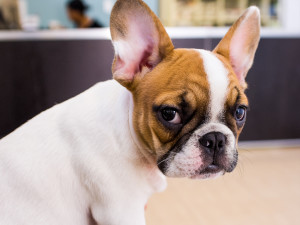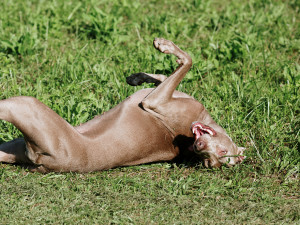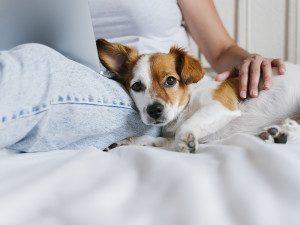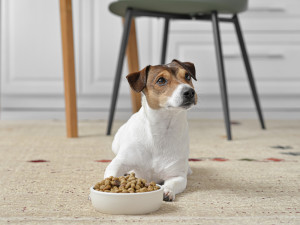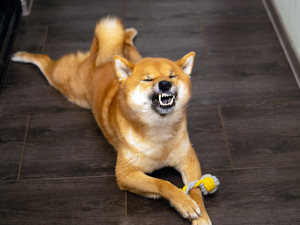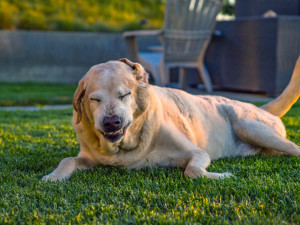Reverse Sneezing or Honking Noise in Dogs: Causes and Treatment
Don’t panic: It’s called reverse sneezing, and in most cases, it’s nothing to worry about.
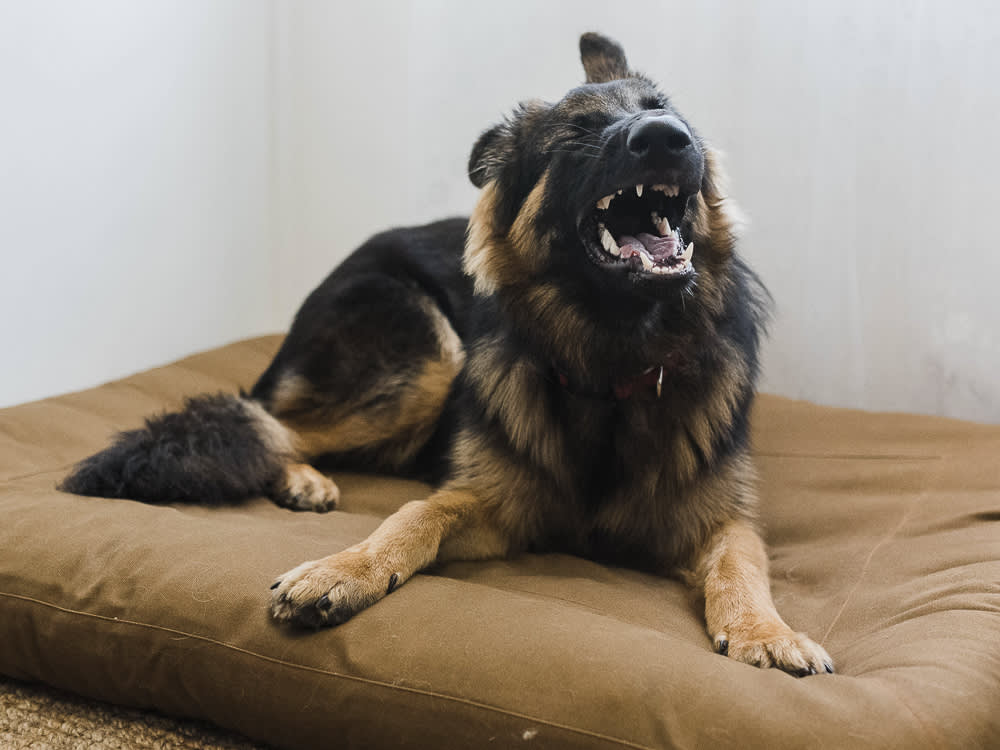
Share Article
In This Article:
What Is Reverse Sneezing?opens in new tab What Causes Reverse Sneezing? How to Diagnose Reverse Sneezing in Dogs How to Treat Reverse Sneezing in Dogs Are Certain Dog Breeds Prone to Reverse Sneezing? How to Stop Reverse Sneezing in Dogs Frequently Asked Questions
You’re hanging out with your dog when they suddenly start making a weird breathing sound as though they’re trying to simultaneously hack something up, honk like a goose, and/or suck in air through a whoopie cushion. This odd noise understandably may lead you to panic, thinking that your dog is having trouble breathing, or they’re choking and in big trouble.
That strange noise is called reverse sneezing. It’s a spasm that occurs in the back of the throat and is usually harmless. Most of the time, it lasts only a few seconds and stops on its own well before you can seek medical attention. Keep reading to learn more about reverse sneezing in dogs.
Main takeaways
Reverse sneezing is usually a harmless condition that resolves quickly on its own.
Many possible causes can trigger this kind of spasm.
Some conditions can resemble reverse sneezing but are more serious, so be sure to see a vet if any signs persist beyond a few minutes.
What is reverse sneezing?
Reverse sneezing is a common condition caused by a spasm in the back of a dog’s throat. When this happens, a dog tries to rapidly inhale through their nose, but their throat muscles spasm, creating a loud snorting sound. Technically known as inspiratory paroxysmal respiration, it is usually harmless, lasts only a few seconds, and stops on its own. It can be distressing to both people and dogs, and while this is happening, dogs may stand with a tense body, neck extended, nostrils flared, and/or a wide stance in their limbs.

What does reverse sneezing sound like in dogs?
Reverse sneezing in dogs sounds a bit like a dog “inhaling a sneeze,” which is where the name originated from. Usually, there is an intense sucking sound as a dog tries to inhale, followed by a strange snorting or reverberating sound as that air vibrates through their spasming throat.
What causes reverse sneezing?
Anything that irritates the nose or the back of the throat, including the soft palate or roof of the mouth, can result in a spasm and reverse sneezing. Some of the most common causes include:
excitement and/or heavy exercise, especially if they are pulling on their leash
eating or drinking quickly
nasal mites
foreign bodies caught in the nose, including foxtails
environmental irritants such as household chemicals, dust, perfume, and cigarettes
environmental allergies, including pollen
upper respiratory infections caused by bacteria or viruses
post-nasal drip
anatomical abnormalities with the nose or throat, including a shortened nose and/or elongated soft palate, as seen in many brachycephalic breeds
How to diagnose reverse sneezing in dogs
The telltale signs of reverse sneezing are the specific sound they make as well as the fact that the episode ends within a few seconds and your dog seems completely fine afterwards. Since these episodes are so short, there usually is not enough time to get them to a veterinarian for a diagnosis unless you can record a video in the moment.
If you look at your dog’s gums during an episode, they should be bubble-gum pink, not dark red or bluish, indicating that they are still getting plenty of oxygen. If your dog’s gums do not have a healthy pink color, or if your dog continues to have strange episodes or other signs of illness, be sure to see a vet for a proper evaluation to rule out other causes for abnormal breathing.
How long do episodes of reverse sneezing last?
These episodes usually only last a few seconds, and most dogs will have one isolated episode, or they may happen very sporadically. In rare cases, this can be a recurrent or chronic problem; in those cases, it is important to seek veterinary care to determine the underlying cause and find effective treatments.
How to treat reverse sneezing in dogs
Reverse sneezing rarely requires treatment. When the sneezing stops, the spasm is over, and dogs should return to normal.
If the episode continues beyond a few seconds, massaging your dog’s throat can help stop the spasm. If your dog seems distressed, it can help to speak in a soft, low voice and pet them gently to help calm them down. Try to avoid stressing them out by picking them up, coaxing them to walk, or moving them to another location; it is best to let them stay put until the episode passes.
Are certain dog breeds prone to reverse sneezing?
Yes, some dogs are more likely to experience reverse sneezing. Brachycephalic breeds that have flat faces, such as Pugs, French Bulldogs, Boxers, Pekingese, and Shih Tzus tend to have certain anatomical abnormalities, including an elongated soft palate, that put them at risk for reverse sneezing. Small breed dogs, including Yorkies, Dachshunds, Chihuahuas, Miniature Pinschers, and Papillons are also more prone to reverse sneezing because they have smaller throats which can more easily spasm.
How to stop reverse sneezing in dogs
There’s no foolproof way to stop a reverse sneeze once it has started. The best thing you can do when your dog reverse sneezes is gently massage their throat and soothe them with a calm voice.
If your dog is having these episodes frequently, it is worth seeing your vet to dig into why it’s happening and check for the common underlying causes, such as allergies, nasal mites, and/or foreign bodies, which can be successfully treated and bring your pup relief.
FAQs
Can reverse sneezing in dogs be caused by stress?
If stress causes your dog to become overly excited, breathe hard, pull on their leash, or eat or drink quickly, it could induce a reverse sneeze. Anything that irritates the back of the throat can lead to a spasm.
Is reverse sneezing related to choking or a blockage in the throat?
Reverse sneezing is not related to choking or a blockage of the throat; it is caused by a spasm of the muscles of the throat. If a foreign object is irritating your dog’s nose or throat, it could cause reverse sneezing. A blockage of their throat is an emergency as it can interfere with their ability to breathe, so if the episode lasts more than a few seconds, head to the vet.
Can reverse sneezing be prevented?
In most cases, reverse sneezing cannot be prevented. It usually happens spontaneously, when something irritates a dog’s nose or throat and resolves very quickly. However, if you know your dog is triggered to reverse sneeze by something specific, such as certain odors, cigarette smoke, pollen, or excitement, you can take steps to avoid those triggers, pre-treat with antihistamines, and/or work on behavior modification exercises to reduce the likelihood of an episode.
When should I worry about reverse sneezing?
If your dog is having frequent episodes of reverse sneezing and/or other signs of illness, it is important to see a vet for evaluation. Some causes of reverse sneezing can be treated and bring your dog relief.
What can be mistaken for reverse sneezing in dogs
Other breathing abnormalities can sometimes be confused with reverse sneezing, including acute problems such as choking, respiratory infections, and/or coughing. It can also include more chronic conditions like collapsing trachea, laryngeal paralysis, and/or stertorous breathing that occurs in dogs with Brachycephalic Syndrome.
References
Hold, DE, et al. “Nasal Polyps in Dogs: Five Cases (2005 to 2011)opens in new tab.” Journal of Small Animal Practice, vol. 52, no. 12, December 2011, pp. 660-663.
Talavera, Jesus, et al. “Reverse Sneezing in Dogs: Observational Study in 30 Casesopens in new tab.” Veterinary Science, vol. 9, no. 12, 2022, pp. 665.
Wills, SJ, et al. “Pneumonyssoides species infestation in two Pekingese dogs in the UKopens in new tab.” Journal of Small Animal Practice, vol. 49, no. 2, February 2008, pp. 107-109.
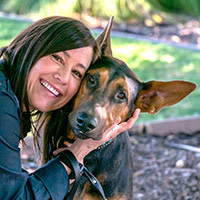
Dr. Shea Cox, DVM, CVPP, CHPV
Dr. Shea Cox is the founder of BluePearl Pet Hospice and is a global leader in animal hospice and palliative care. With a focus on technology, innovation and education, her efforts are changing the end-of-life landscape in veterinary medicine.

Dr. Amy Fox, DVM
Amy Fox, DVM is a small animal veterinarian in New York City with over thirteen years of experience in a mixture of general practice, emergency medicine, and shelter medicine. A lifelong animal lover, Dr. Fox studied biology in college and then worked as a veterinary nurse before pursuing veterinary school at Cornell University. Her expertise includes surgery, dentistry, and management of chronic conditions, and she is interested in toxicology, pain management, nutrition, care of senior pets, and educational outreach. Dr. Fox also enjoys writing about veterinary medicine and teaching, and her work has previously appeared in Spruce Pets. In her free time, she loves to cook, garden, go for long runs, and hang out with her goofy mixed-breed dog May, who provides never ending comic relief!
Related articles
![French bulldog puppy looking scared at vet]()
10 Things to Ask at Your First Vet Visit
There are no stupid questions — well, when it comes to your dog’s health.
![Cute weimaraner dog lying on lawn and scratching its back]()
Best Allergy Medicines That You Can Give to Your Dog
Here’s what works (and what doesn’t).
![Dog sitting next to owner]()
DIY Pet Physical Exam: How to Check Your Dog’s Breathing & Skin
Veterinarian Dr. Shea Cox on how to get comfortable checking your dog’s breathing, respiratory rate, and skin hydration.
![A dog sitting on the floor with a bowl of kibble.]()
Everything You Need to Know About Your Dog’s Gut Microbiome
Microscopic organisms may reveal pathways to better health for your pet.
![Shiba inu dog sneezing.]()
Bless Them! Why Do Dogs Sneeze When They Play?
It’s adorable, but there are actual reasons behind this behavior.
![dog sneezing outside in grass]()
Why Do Dogs Sneeze?
Other than to completely freak you out.
